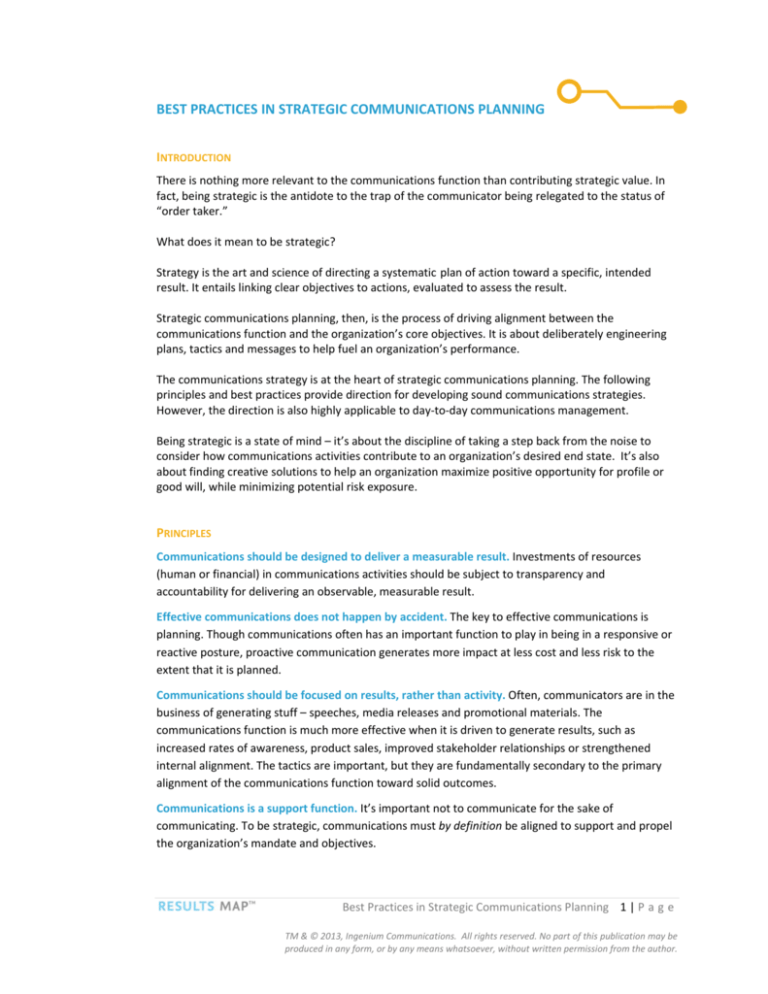
BEST PRACTICES IN STRATEGIC COMMUNICATIONS PLANNING INTRODUCTION There is nothing more relevant to the communications function than contributing strategic value. In fact, being strategic is the antidote to the trap of the communicator being relegated to the status of “order taker.” What does it mean to be strategic? Strategy is the art and science of directing a systematic plan of action toward a specific, intended result. It entails linking clear objectives to actions, evaluated to assess the result. Strategic communications planning, then, is the process of driving alignment between the communications function and the organization’s core objectives. It is about deliberately engineering plans, tactics and messages to help fuel an organization’s performance. The communications strategy is at the heart of strategic communications planning. The following principles and best practices provide direction for developing sound communications strategies. However, the direction is also highly applicable to day‐to‐day communications management. Being strategic is a state of mind – it’s about the discipline of taking a step back from the noise to consider how communications activities contribute to an organization’s desired end state. It’s also about finding creative solutions to help an organization maximize positive opportunity for profile or good will, while minimizing potential risk exposure. PRINCIPLES Communications should be designed to deliver a measurable result. Investments of resources (human or financial) in communications activities should be subject to transparency and accountability for delivering an observable, measurable result. Effective communications does not happen by accident. The key to effective communications is planning. Though communications often has an important function to play in being in a responsive or reactive posture, proactive communication generates more impact at less cost and less risk to the extent that it is planned. Communications should be focused on results, rather than activity. Often, communicators are in the business of generating stuff – speeches, media releases and promotional materials. The communications function is much more effective when it is driven to generate results, such as increased rates of awareness, product sales, improved stakeholder relationships or strengthened internal alignment. The tactics are important, but they are fundamentally secondary to the primary alignment of the communications function toward solid outcomes. Communications is a support function. It’s important not to communicate for the sake of communicating. To be strategic, communications must by definition be aligned to support and propel the organization’s mandate and objectives. Best Practices in Strategic Communications Planning 1 | P a g e
TM & © 2013, Ingenium Communications. All rights reserved. No part of this publication may be produced in any form, or by any means whatsoever, without written permission from the author.
Plan communications from the inside out. Communications planning should always include consideration of employees as a key audience – staff can greatly contribute to communications efforts, excluding them from communications activities can be erosive to internal engagement and trust. When planning communications, consider the concept of starting from the inside, then moving out to stakeholders, such as the Board of Directors and other key stakeholders as priority audiences, even if ultimately a communications activity is directed toward an external audience base. BEST PRACTICES #1: Set clear, measurable objectives. The single most important step to sound communications planning is carefully setting objectives. Crafting communications objectives is difficult – it may be the most challenging aspect of the planning process. Setting out clear objectives which define “what success looks like” is fundamental to strategic communications planning. Think about developing SMART objectives that are specific, measurable, action‐oriented, realistic and time‐bound. Generally, three to five objectives written as distinct, stand‐alone statements work best. Guard against the tendency to prescribe tactics within objectives. Focus on what you’re trying to achieve, rather than how you’ll achieve it. Take the time to be precise – do you want to engage employees in order to increase their job satisfaction? Or is it to improve retention rates? Is the focus on establishing a reputation, or in building relationships? Once you’ve established your objectives, get them validated internally by all key stakeholders to ensure that you’re not wasting time developing a plan against objectives that may be off target. #2: Drive alignment. When working on objectives, validate that the communications objectives are in alignment with the organizational objective. This is important in the case of a corporate communications strategy, but is just as relevant in the case of a program‐ or issue‐specific campaign. Think about what your organization is trying to achieve first – then consider how communications can help you get there. #3: Set yourself up for success. Sound strategic communications planning requires a strong foundation in preparation. Before embarking on any strategic planning exercise, make sure that you have the right information and insights to guide the process. That will include research such as public environment analysis, public opinion data, media and blog scans as well as reviews of stakeholder documents as appropriate. The other core dimension of preparatory work is consultation. Reach out and talk to the key internal or external sources as appropriate to ensure that you have conducted an appropriate strategic consideration analysis which enables you to fully understand the risks and opportunities of your communications topic. By definition, that will include assessing the issue landscape, understanding the key players and audiences and getting a sense for existing and potential tactical performance. Best Practices in Strategic Communications Planning 2 | P a g e
TM & © 2013, Ingenium Communications. All rights reserved. No part of this publication may be produced in any form, or by any means whatsoever, without written permission from the author.
#4: Focus on audiences. Develop your strategic communications planning process through the lens of your audiences. This will ensure that your approaches are relevant and resonant – both in terms of messages and tactics. Adopting an audience‐centric approach is critical to effective communications planning. Executing on this strategy will require that you collect appropriate information about your audiences, including mapping out stakeholders as appropriate. #5: See messaging as your core product. Consider that messaging is ultimately the core product of your strategic communications planning process. It’s not about all the “stuff” to get your messages out – fundamentally communication is about bringing your message to life. Invest the time to craft a powerful message architecture that is deliberately crafted through an audience‐centric approach of “outside‐in” thinking. Make a point of writing messages based on value that answer the question – “what’s in it for me?” #6: Design the tactical mix strategically. Think strategically about your communications tactics. Consider what communications activities best meet your needs, based on your understanding of the strategic landscape, your audience profile and your message. Often, this will mean challenging the status quo of existing communications tactics that are produced. Have the courage to ask tough questions and validate whether the communications products your organization produces are best suited to meet your strategic objectives. If not, consider eliminating lower‐producing tactics in order to create bandwidth for innovation and impact. #7: Establish the fundamentals. As part of the strategic communications planning process, take the time to consider the fundamentals for success. Specifically: •
Project management – ensuring that systems are in place to manage the implementation of the communications activity and provide oversight for the variables of time, money and quality. •
Resourcing – budget appropriate staff and financial resources in order to ensure that you can effectively deliver against the plan. •
Engagement – take the time to consider internal engagement and buy‐in. Build key constituents into the strategic communications planning process early so that they are part of the plan. This will help drive internal alignment and support for the strategy’s execution. Best Practices in Strategic Communications Planning 3 | P a g e
TM & © 2013, Ingenium Communications. All rights reserved. No part of this publication may be produced in any form, or by any means whatsoever, without written permission from the author.
#8: Measure, refine, report. The most significant weakness on the part of communicators is generally measurement. Evaluating your communications program is critical to your value, your success and your internal credibility. Measurement does not have to be costly or complicated – begin by reviewing your objectives and identifying performance indicators for each one. Think about what you would observe as evidence of a change or improvement that would let you know you’ve succeeded. Focusing on indicators, rather than measurement tools is often a useful way to adopt a more practical approach to evaluation. Once you define what success looks like, it becomes easier to identify measurement tools that can be used to track performance. For example, if media coverage is an important indicator of performance, media monitoring is the logical measurement tool required. Build de‐brief sessions into routine project management approaches so that evaluation becomes part of your day‐to‐day operation and culture. Remember to have an activist approach to measurement – measure not just for the sake of justifying expenses, but as part of a demonstrated commitment to performance. Finally, don’t forget to report on your findings. This is a vital and often overlooked step in communications planning. Consider who might benefit from learning from the evaluation process and how to share information in order to contribute to continuous improvement. This discipline is extremely valuable in ensuring that teams avoid re‐inventing the wheel, or worse – repeating the same mistakes. Get More
Contact us for more information on how these best practices can be leveraged to meet your organization’s communications objectives. www.resultsmap.com Best Practices in Strategic Communications Planning 4 | P a g e
TM & © 2013, Ingenium Communications. All rights reserved. No part of this publication may be produced in any form, or by any means whatsoever, without written permission from the author.
BE Strategic, add value,
do more with less.
Want to become a communications rock star? Get started
with the Results Map Handbook. Full of easy to use templates,
worksheets, samples and case studies covering the full spectrum
of communications, the Handbook is your ticket to stardom.
Get your copy today!
BUY
NOW
for $129
Learning Opportunities
Book
Using tools and templates that are easily applied to your
day-to-day, our retreats and training workshops provide
common ground that can transform the strategic impact
of your communications team.
Find the workshop that’s right for you!
YOUR WORKSHOP
NOW
info@resultsmap.com
613.729.1721
www.resultsmap.com







